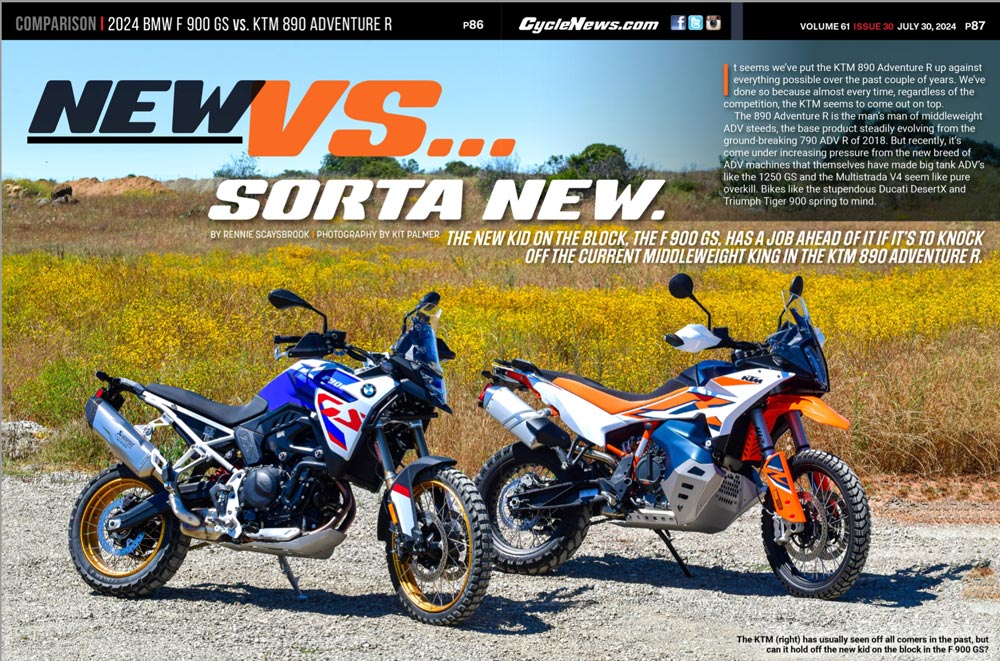Rennie Scaysbrook | August 4, 2024
It seems we’ve put the KTM 890 Adventure R up against everything possible over the past couple of years. We’ve done so because almost every time, regardless of the competition, the KTM seems to come out on top.
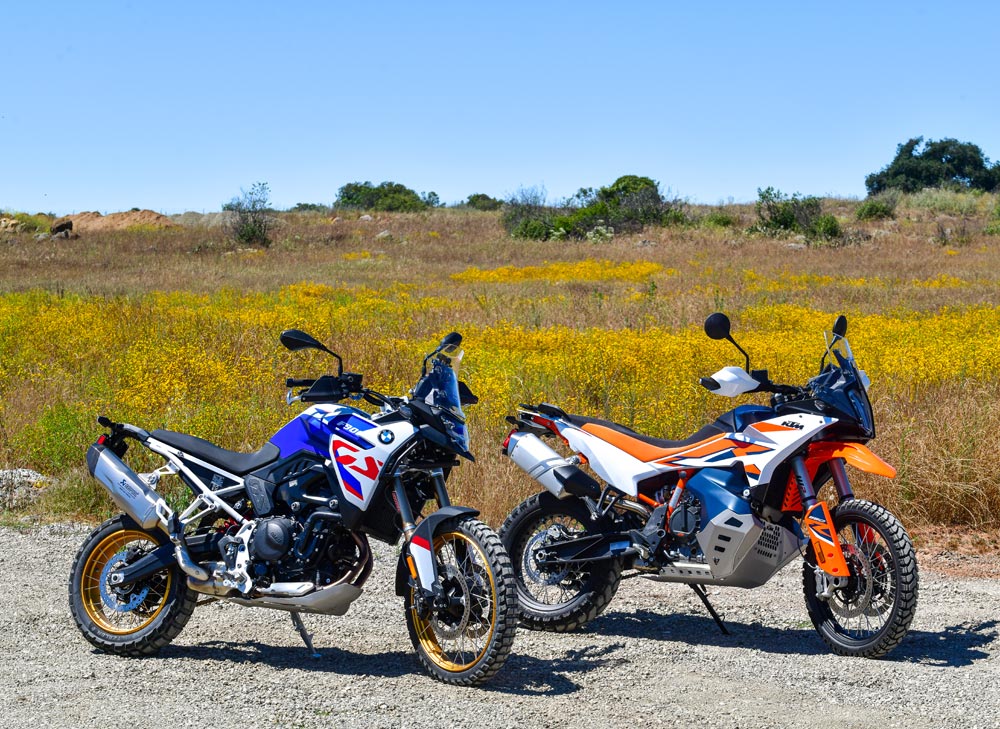 The KTM (right) has usually seen off all comers in the past, but can it hold off the new kid on the block in the F 900 GS?
The KTM (right) has usually seen off all comers in the past, but can it hold off the new kid on the block in the F 900 GS?
Photography by Kit Palmer
The 890 Adventure R is the man’s man of middleweight ADV steeds, the base product steadily evolving from the ground-breaking 790 ADV R of 2018. But recently, it’s come under increasing pressure from the new breed of ADV machines that themselves have made big tank ADV’s like the 1250 GS and the Multistrada V4 seem like pure overkill. Bikes like the stupendous Ducati DesertX and Triumph Tiger 900 spring to mind.
BMW has been missing from this increasingly focused game. The last time the 850 GS got an update was way back in 2019, and the middleweight ADV class is now barely recognizable from then. BMW has been seriously on the front foot of late, producing a slew of new bikes, including the highly acclaimed R 1300 GS, so it was only a matter of time before the 850 got the boot and replaced by a far more worthy competitor to the KTM.
Enter the F 900 GS. This is a full redesign of the 850. Indeed, very little is carried over from the old bike.
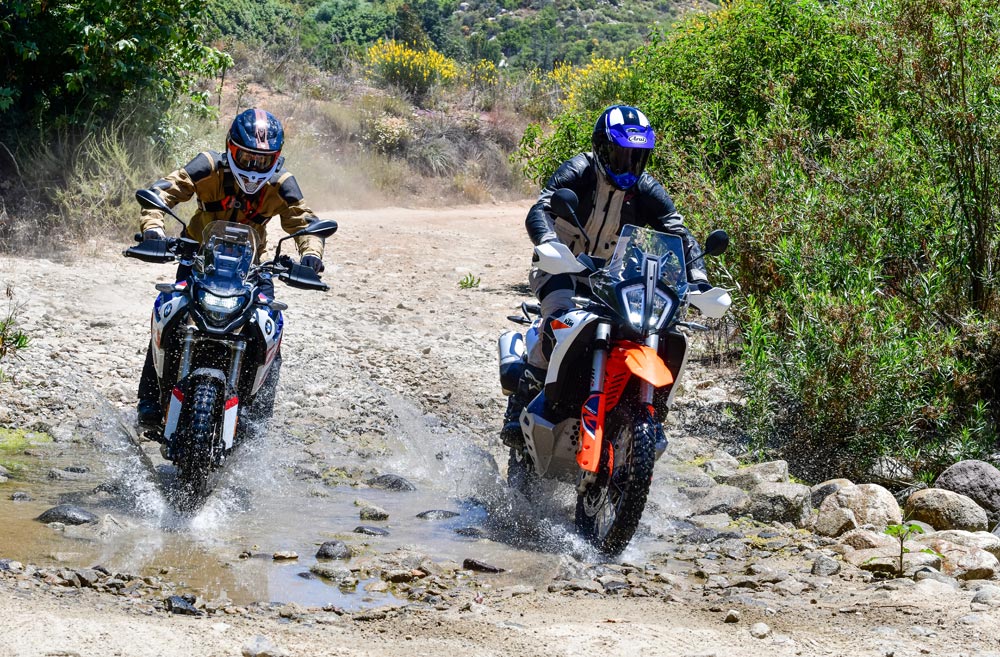 Mild off-roading is easy for both bikes but when things get gnarly, the KTM (left) shows its teeth.
Mild off-roading is easy for both bikes but when things get gnarly, the KTM (left) shows its teeth.
Face Value
The KTM and BMW represent the two halves of the modern midsize ADV market. Or, rather, the KTM makes up half the modern midsize ADV market, while the BMW, Ducati, Honda, Yamaha and Triumph all make up the other half.
I say that because the KTM is short, compact and aggressive in its build, while the BMW (and others) have a much rangier chassis and rider triangle that’s more on the relaxed side of the ride.
A quick look at the vitals backs this up. The BMW’s wheelbase is a considerable 2.4 inches longer than the KTM (62.6 inches vs.60.2 inches); it’s got a slightly more relaxed rake angle at 28° vs.the KTM’s 26.3°, but the two are close on seat heights, only 0.4 in. difference at 34.2 for the BMW and 34.6 for the KTM.
The BMW hasn’t changed its wheel dimensions in its morphing to F 900 GS form, running a 21-inch front and 17-inch rear wheel setup, but purist off-roaders will likely be more drawn to the KTM’s 18-inch rear wheel that matches the 21-inch front.
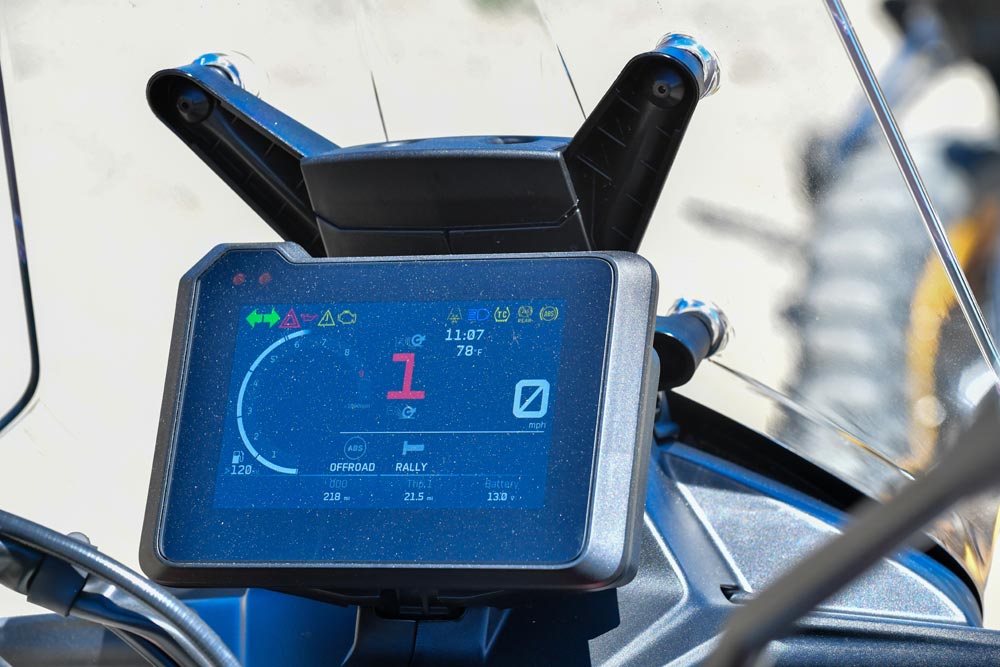 The KTM’s dash hasn’t changed for years and that’s a good thing because it’s so easy to navigate.
The KTM’s dash hasn’t changed for years and that’s a good thing because it’s so easy to navigate.
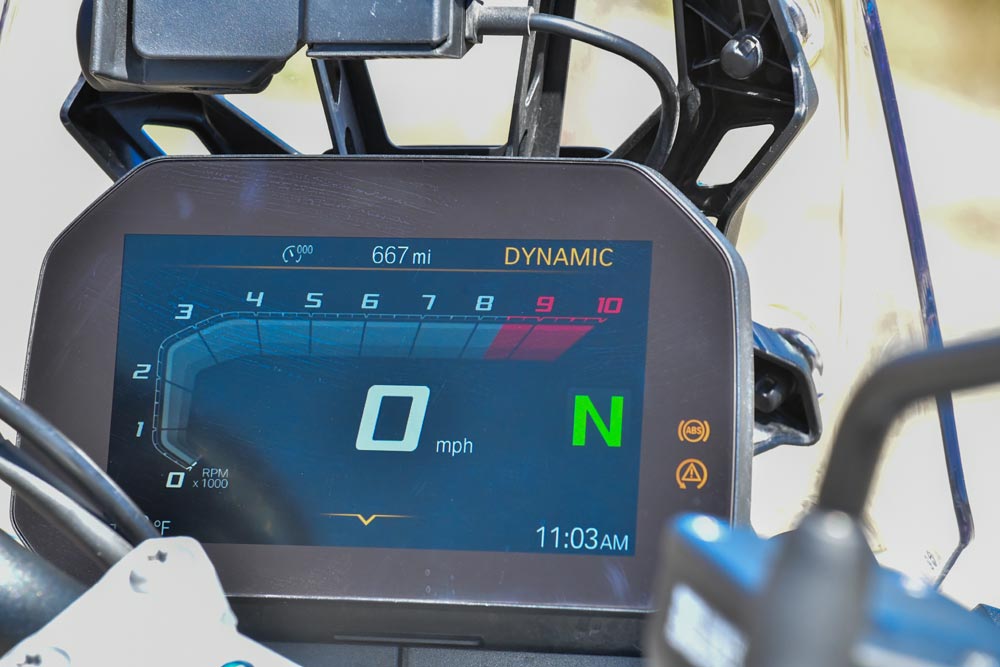
BMW’s dash is shared across almost all its current lineup but takes a bit to get used to. There’s lots of info in there.Engine-wise, the two are now a lot closer than they were in the past. Both run the same parallel-twin configuration, but the BMW tips the capacity scales at 895cc compared to the KTM’s 889cc. They sound quite different, too, with the BMW running a 90-degree crankpin offset and 270/450° firing interval compared to the 75° crankpin offset with 435° firing interval of the KTM, giving the Austrian steed a meatier, rougher sound, like a V-twin.
BMW and KTM claim the same horsepower at 105, although the KTM’s peak comes in 500 rpm sooner than the BMW at 8000 rpm. Torque for the BMW is a claimed 68.8 lb-ft at 8500 rpm, while the KTM rolls with slightly more at 74 lb-ft delivered much earlier at 6500 rpm.
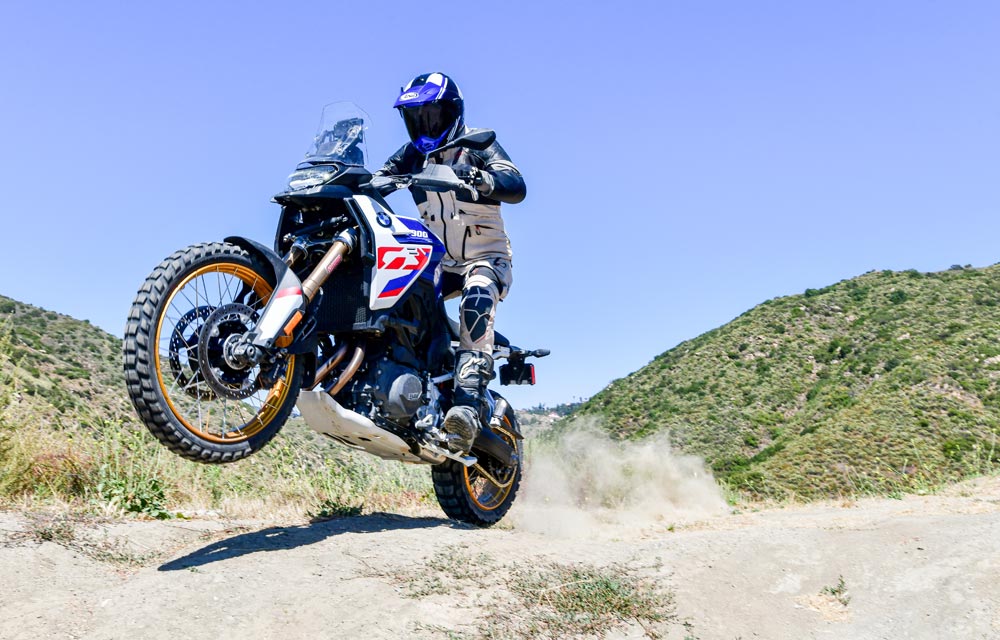 More room to move about on the bike made the BMW Rennie’s favorite. The plush suspension was fine for his level of riding, but more experienced ADV pilots might want something stiffer.
More room to move about on the bike made the BMW Rennie’s favorite. The plush suspension was fine for his level of riding, but more experienced ADV pilots might want something stiffer.
Now For The Add-Ons
It’s nearly impossible to buy a BMW from the dealer without at least some form of electronic accessory add-on; the same is true for KTM. This is where things begin to split between the two bikes.
First, the BMW.
As a base price, the BMW comes in at $14,190, but this is a fair way off what we tested. BMW gave us the full treatment for the GS test bike, lacing it with the GS Trophy red, white and blue paint job, gold spoked wheels and enduro handguards. That added $545 to the sticker price.
Then, we got the Premium Package at $1750, which included the M Endurance Chain, Keyless Ride, GPS Preparation, Tire Pressure Monitor (TPM), Cruise Control, Gear Shift Assist Pro, and Ride Modes Pro, which added the Dynamic, Enduro, and Enduro Pro throttle modes, plus Engine Drag Torque Control.
Still going, we got the Enduro Package Pro for another $1495, which includes the larger 45mm fully adjustable Showa fork and fully adjustable Sachs/ZF shock, the Intelligent Emergency Call for another $345, and the Metzeler Karoo 4 off-road rubber for $65 (the Karoo’s actually cost around $260 for a set, but if you get them from BMW as part of the Enduro Package Pro, they’ll only cost $65. All up, our test bike will set you back $18,390.
 Tighter ergonomics and packaging make the KTM more focused and aimed at more experienced riders.
Tighter ergonomics and packaging make the KTM more focused and aimed at more experienced riders.
Now for the KTM.
The base price for the 2024 KTM 890 Adventure R is a touch more than the BMW at $15,799. We had the optional Tech Pack fitted for $734.99, which includes the Quickshifter+, Motor Slip Regulation and Cruise Control, and the all-important Rally Pack. The Rally Pack features nine-stage adjustable traction control and the Rally ride mode that changes the throttle response.
We also had the $446.99 skid plate and $78.99 KTM air filter kit installed, bringing the total value of the KTM as tested to $17,059.97, a saving of $1330.03 over the BMW.
Bear in mind, too, that the KTM comes with the fat 48mm WP Xplor fully adjustable fork and fully adjustable Xplor shock fitted as standard, whereas you need to trade up those items on the BMW as part of the Enduro Package Pro.
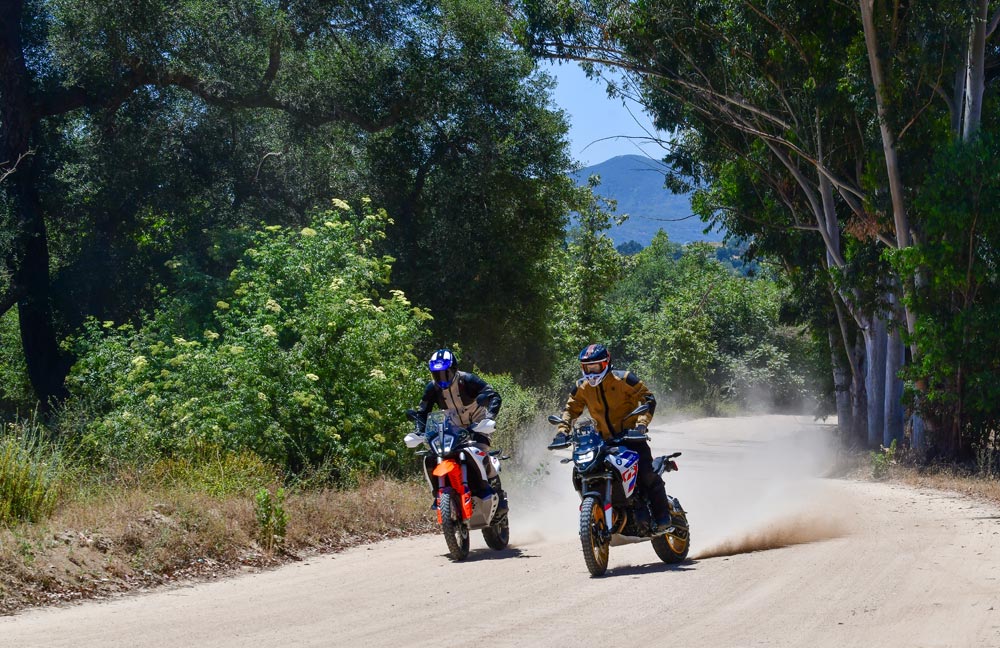 Here the ergos are easy to see. 5’10” Jesse is nearly fully standing tall on the rangy BMW, whereas 6’1” Rennie is a bit more cramped on the KTM.
Here the ergos are easy to see. 5’10” Jesse is nearly fully standing tall on the rangy BMW, whereas 6’1” Rennie is a bit more cramped on the KTM.
Post Ride | 2024 BMW F 900 GS vs. KTM 890 Adventure R Comparison
The Expert Off-Road Rider: Jesse Ziegler
“I like the KTM vibe inside their ADV machines. I always have, and hopefully always will. I like their DNA. And I really like the current midsize adventure class family that houses the 890 Adventure R. With that said, there is absolutely room for improvement. And with a bike that’s getting as long in the development tooth as KTM’s 890 Adventure R is, I really hope they make some improvements soon.
The only real beef I have (and the same complaint that surfaces from riders in comparisons) is this—the 890 ADV R is wound too tightly. To fulfill KTM ADV shoes of the past, it must handle off-road terrain with ease. It must outperform everything on the market and do it easily. It must race. It must win. It must not bend knees to dips, rocks or ruts. The 890 Adventure R works well, very well, at delivering on that promise. But every impact up until you need that ultimate off-road performance is going to have you longing for more comfort, front and rear. Their WP componentry is tuned to the end of the use case. And does not shine in the beginning and middle. When you ride the bike you will feel more road expansion joints, moderate potholes, and all manner of bumps with more aggression. It’s harsh.
I have zero complaints about anything else. Well, maybe the looks—also getting old for me. However, the bike is ergonomically perfect for me (5’10” and 180 pounds) and balanced better than anything in the class. The engine power and electronics package are superior in delivery and function. Brakes are good. Range is fantastic. There’s nothing else to compare.
Then there’s the new BMW F 900 GS. I’ve admittedly had zero desire to ride a midsized BMW ADV bike for at least 10 years. They have all let me down. Give me the big guy boxer twin and all that torque or leave me out of the BMW conversation, thanks. But this bike. This bike looks good. Just look at the gold rims! And with the electronics package and performance potential behind those good looks, I was intrigued.
The motor misses the 890 smoothness and torque for me and signs off sooner than I’d like. It needs revs and then doesn’t deliver on those revs in comparison. But it is smooth and easy to ride without a doubt. Ergonomically, it’s off for me. Comfortable standing, sure. But with a crotch-jamming seat angle towards the street and footpegs set too far back, I was not looking forward to long testing days in the saddle. Slap a flat seat on this thing, and I think we’re in business. Also, the handlebars are high. Really high. Again, great for standing if you want your hands at your belt line, but for those of us just under six foot tall, they are gangly. If you’re 5’6” or so, this bike is going to be a handful.
However, when she moves, the bike is butter smooth. It gobbles road chatter up with ease and gives the rider a sense of stability and predictability that I long for in the KTM. Off-road it is fine. It handles all but the most aggressive impacts great but handles all the smaller ones better. It is also much more stable across varying surfaces. From sand to hard-pack rock, the BMW goes in-line where you want it to. The KTM will dance and snap you in or out of your line. The BMW brings welcomed comfort to this comparison. It will win a lot of hearts in doing so.
I’ll probably keep suffering through the bumps and ride the KTM until my wrists fall off since it fits me the best, and I just love the power and electronics package. But wouldn’t it be amazing if they made increasing comfort a priority one of these years?”
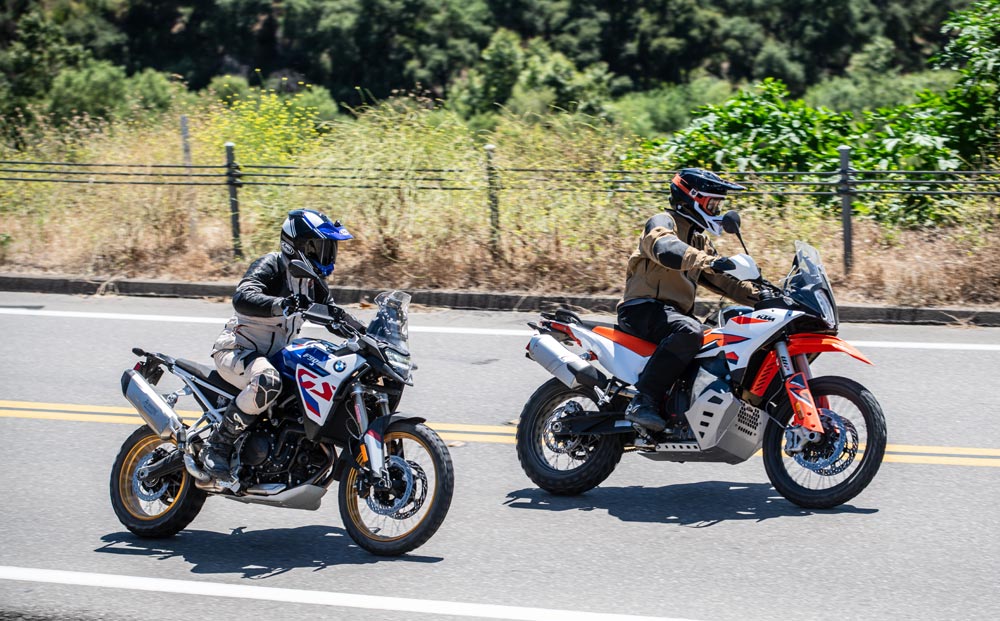 It’s hard to beat the BMW’s comfort on the pavement. The KTM couldn’t.
It’s hard to beat the BMW’s comfort on the pavement. The KTM couldn’t.
The Not-So-Expert Off-Road Rider: Rennie Scaysbrook
I’ve done so many miles on the KTM 890 Adventure R over the years I’ve lost count. At first, way back in 790 guise, I was fairly convinced this was the best midsize ADV platform ever created, now, I’m not so sure.
The 890 ADV R comes rolling with all the goods to make it the class king. Starting with the obvious like (if you’re into, you know, going places) fuel capacity. The KTM holds a stout 1.5 gallons more than the BMW, and that trademark low-slung gas tank gives the machine exceptional stability over the rough stuff.
And I love the fact you don’t have to trade up to get the fancy suspension. The WP Xplor front and rear springers, developed by America’s own badass Quinn Cody, are almost overkill for most people. They’ll handle anything normal people can throw at them and almost everything Quinn can throw at them, but herein lies one of the problems with the KTM—it’s just too damn harsh on everything except when you’re really going for it off-road.
Everything about the 890 is, like Jesse said, too “wound up.” I’m three inches taller than Jesse at 6’1”, and the compact rider triangle, combined with the stiff suspension in standard form, makes the KTM not that enjoyable over a long distance.
Running over potholes on the tarmac will send shocks to the rider that I feel should have been damped out. It’s odd because the ergonomics, plus the behavior of the suspension, make the KTM feel like a street bike for the dirt, not a dirt bike for the street, as the BMW does.
The KTM’s electronics are superb—easier to use than the BMW and more effective when deployed. Perhaps it’s because I’ve had so much experience with the KTM that I find their user interface so intuitive, but I have yet to meet anyone who has a bad word to say about the KTM’s electronics.
On the motor side, the KTM’s extra torque and the fact that its peak number is achieved significantly lower in the rev range make it easier to get the most out of the BMW. The KTM’s throttle response is smooth off the bottom and will pull from low revs in higher gears with less protesting than the BMW, making it better in slow-speed, rocky uphill sections.
On the other hand, the BMW was a real surprise package. The 850 GS felt like a bit of a toy compared to the 900, which is now a true alternative to the KTM. But it’s not perfect.
The motor delivers much peakier torque than the KTM. Whether this is due to emissions or not (BMW has a modern history of flat spots thanks to the U.S. emissions laws it has to contend with), it’s still a blight on the GS’s copybook.
However, there’s still plenty of performance on offer from BMW’s parallel-twin. Get it spinning with the revs higher and it’s a brilliant motor to experience, matched to a velvety smooth throttle delivery in Enduro Pro mode.
However, for me, the real clincher in going for the BMW was two-fold: the enormous difference in suspension comfort and the roomier rider triangle. In creating the 900, the footpegs that are 0.79 inches lower than on the 850, the handlebar is 0.5 inches higher, and the revamped seat that is 34.3 inches high (a lower 32.9-inch seat is also available). For lanky bastards like me, that makes music to the ADV ears, especially when standing up. For Jesse, the higher bars and reworked pegs were a no-go, but I’m not buying a 900 GS to go on-roading. There are plenty of bikes in BMW’s lineup that do that way better than a 900 GS, so my bike will be predominantly off-road, which is where those ergonomics shine.
Finally, even though the forks are 3mm smaller than the beefy KTM’s, they provide a much more pleasant ride for 99 percent of the riding I personally would do. Unless I were ripping up in the Baja 1000, the 45mm Showa units on the BMW are just fine. They absorb sharp-edged rocks and potholes better than the KTM, which had me whining at each photo stop.
In much the similar way I picked the Ducati DesertX over the KTM when we tested them last year, I’m going for the BMW on this one. The KTM is too hyper-focused on breaking whatever records you have in mind and doesn’t factor in enough comfort. The market has changed a lot since the 790 came out six years ago, and KTM needs to back off the Ready To Race mindset a touch and create a Ready To Adventure midsize with a degree of comfort and rangier ergos built in.
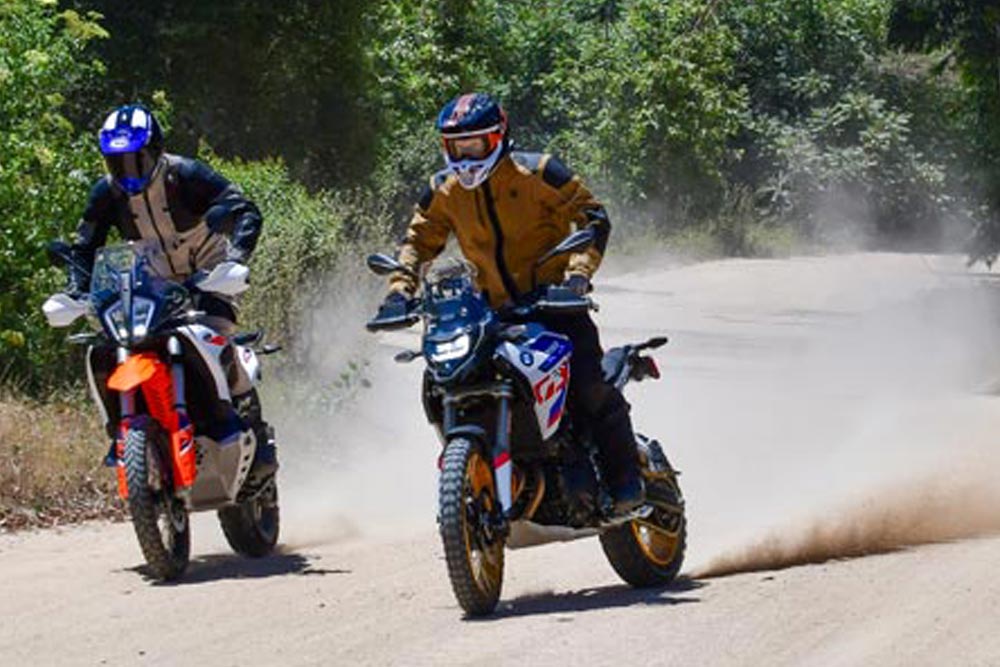
That’s a Wrap | 2024 BMW F 900 GS vs. KTM 890 Adventure R Comparison
Based on the evaluations of our two ADV “experts,” it’s clear that there is no definitive winner between the BMW F 900 GS and KTM 890 Adventure R. One would prefer to see the BMW in his garage at the end of the day while the other the KTM. However, it’s evident that both bikes are excellent for both on-road and off-road adventures. If you prefer riding with a preference for pavement, the BMW might be the better choice. It’s a terrific street bike that also performs well off-road. On the other hand, if you enjoy more off-road adventures and prefer never to share the roads with Teslas and semi-trucks or stop for fuel very often, the KTM might be the more suitable option for you.
The ball is now in your corner. CN
VIDEO| BMW F 900 GS vs. KTM 890 Adventure R Comparison
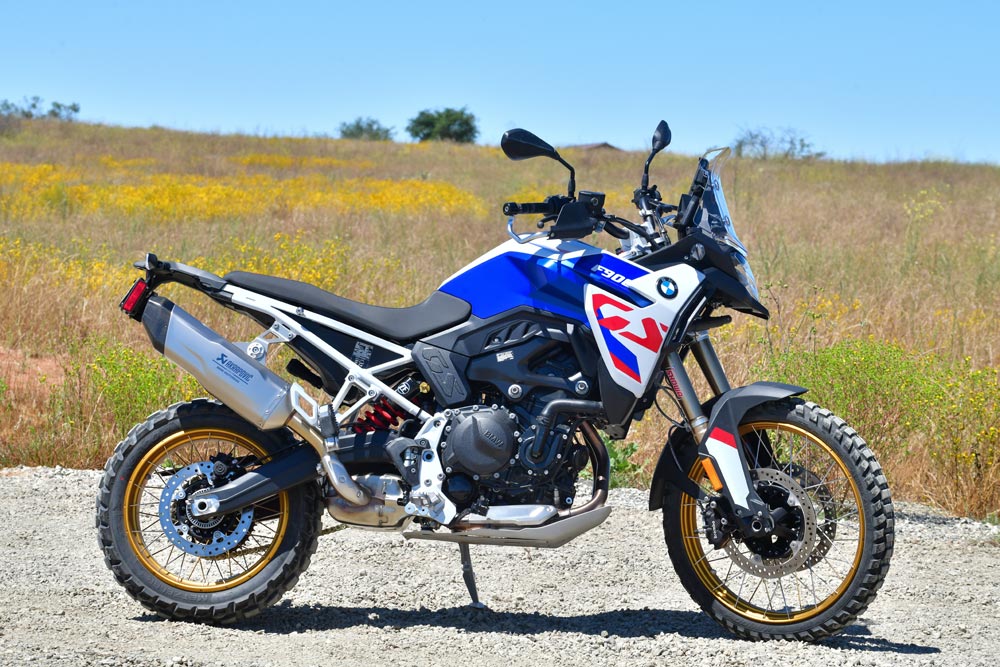
2024 BMW F 900 GS Specifications
| MSRP |
$18,390 (As tested) |
| Engine |
Parallel-twin |
| Valvetrain |
8-valve, DOHC |
| Displacement |
895cc |
| Bore x Stroke |
86 x 77mm |
| Cooling system |
Liquid |
| Power |
105 hp at 8500 rpm |
| Torque |
68.6 ft-lb at 8500 rpm |
| Transmission |
6-speed |
| Fuel capacity |
3.8 gal. |
| Chassis |
Bridge type, steel shell construction |
| Front suspension |
45mm Gold Showa USD telescopic forks, fully adjustable, with Enduro Pro package |
| Rear suspension |
Single, fully adjustable Sachs rear shock with piggyback reservoir, fully adjustable |
| Front-wheel travel |
9.1 in. |
| Rear-wheel travel |
8.5 in. |
| Front brake |
Brembo 2-piston floating caliper, dual 305mm discs, BMW ABS Pro |
| Rear brake |
Single-piston caliper, 265mm disc BMW ABS Pro |
| Front wheel |
Aluminum spoked 2.15 x 21 in. |
| Rear wheel |
4.25 x 17 in. |
| Wheelbase |
62.6 in. |
| Seat height |
34.2 in. |
| Head angle |
28° |
| Weight (Measured, wet) |
498 lbs. |
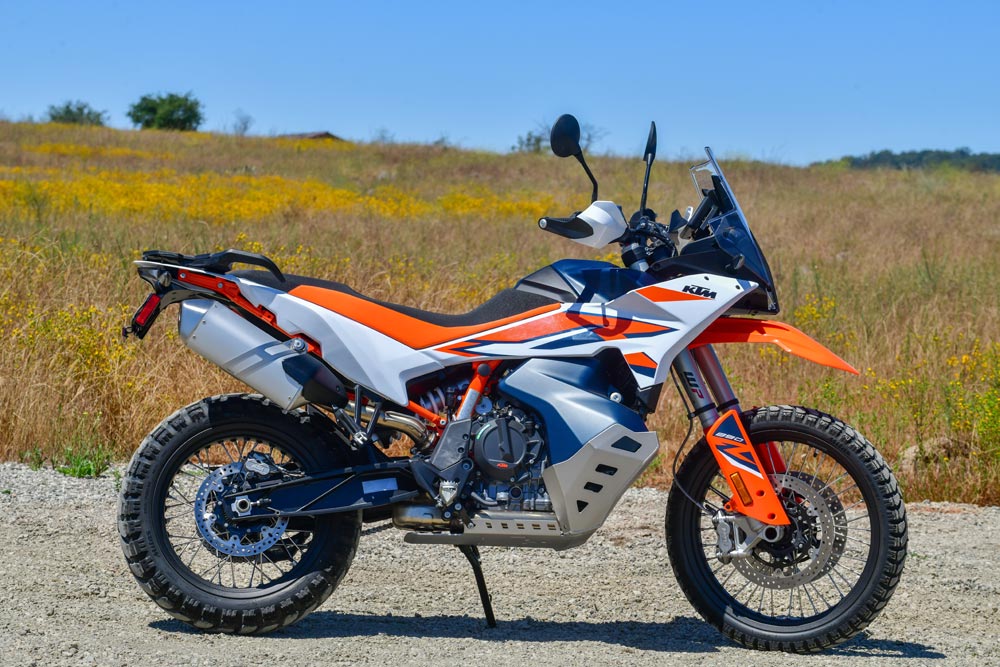
2024 KTM 890 Adventure R Specifications
| MSRP |
$17,059.97 (As tested) |
| Engine |
Parallel-twin |
| Valvetrain |
8-valve, DOHC |
| Displacement |
889cc |
| Bore x Stroke |
68.8 x 90.7mm |
| Cooling system |
Liquid |
| Power |
105 hp at 8000 rpm |
| Torque |
74 lb-ft at 6500 rpm |
| Transmission |
6-speed |
| Fuel capacity |
5.3 gal. |
| Chassis |
Tubular steel |
| Front suspension |
48mm WP Xplor inverted fork, fully adjustable |
| Rear suspension |
Single, WP Xplor shock, fully adjustable |
| Front-wheel travel |
9.4 in. |
| Rear-wheel travel |
9.4 in. |
| Front brake |
Four-piston radial-mount calipers, 320mm discs, Cornering ABS |
| Rear brake |
Single piston caliper, 260mm disc, Cornering ABS |
| Front wheel |
Aluminum spoked 2.50 x 21 in. |
| Rear wheel |
4.50 x 18 in. |
| Wheelbase |
60.2 in. |
| Seat height |
34.6 in. |
| Head angle |
26.3° |
| Weight (Measured, wet) |
480 lbs. |
